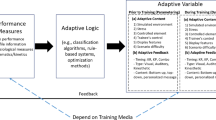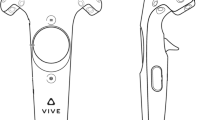Abstract
Virtual environments (VE’s) and simulations are being employed for training applications in a wide variety of disciplines, both military and civilian. The common assumption is that the more realistic the VE, the better the transfer of training to real world tasks. However, some aspects of task content and fidelity may result in stronger transfer of training than even the most high fidelity simulations. A physiologically-based system capable of dynamically detecting changes in operator behavior and physiology throughout a VE experience and comparing those changes to operator behavior and physiology in real-world tasks, could potentially determine which aspects of VE fidelity will have the highest impact on transfer of training. Thus, development of training assessment and guidance tools that utilize operator behavior and physiology to determine VE effectiveness and transfer of training are needed.
Chapter PDF
Similar content being viewed by others
References
Ahlstrom, U., Friedman-Berg, F.: Controller scan-path behavior during severe weather avoidance (DOT/FAA/TC-06/07). Atlantic City International Airport, NJ: Federal Aviation Administration William J. Hughes Technical Center (2006)
Andreassi, J.L.: Psychophysiology: Human Behavior & Physiological Response, 3rd edn. Lawrence Erlbaum Associates, Hillsdale (1995)
Backs, R.W., Lenneman, J.K., Sicard, J.L.: The Use of Autonomic Components to Improve Cardiovascular Assessment of Mental Workload in Flight. International Journal of Aviation Psychology 9(1), 33–47 (1999)
Baumgartner, T., Valko, L., Esslen, M., Jancke, L.: Neural Correlate of Spatial Presence in an Arousing and Noninteractive Virtual Reality: An EEG and Psychophysiology Study. Cyberpsychology and Behavior 9(1), 30–45 (2006)
Bürki-Cohen, J., Go, T.H., Chung, W.W., Schroeder, J., Jacobs, S., Longridge, T.: Simulator Fidelity Requirements For Airline Pilot Training And Evaluation Continued: An Update On Motion Requirements Research. In: Proceedings of the 12th International Symposium on Aviation Psychology (April 2003)
Healy, J.A., Picard, R.W.: Detecting Stress During Real-World Driving Tasks Using Physiological Sensors. Cambridge Research Laboratory, HP Laboratories Cambridge, MA. HPL-2004-229 (2004)
Lawlor, M.: Human-computer interface gets personal. Signal, July 2006 issue (2006), Accessed on Feb 15th, 2007 at http://www.afcea.org/signal/articles/templates/SIGNAL_Article_Template.asp?articleid=1159&zoneid=188
Meehan, M., Insko, B., Whitton, M., Brooks, F.P.: Physiological measures of presence in stressful virtual environments. In: Proceedings of the 29th Annual Conference on Computer Graphics and Interactive Techniques, San Antonio, TX (2002)
Prinzel, L.J., Pope, A.T., Freeman, F.G., Scerbo, M.W., Mikulka, P.J.: Empirical Analysis of EEG and ERPs for Psychophysical Adaptive Task Allocation. NASA-Langley Technical Report No. TM-2001-211016 (2001)
Schmorrow, D.D. (ed.): Foundations of Augmented Cognition. Lawrence Erlbaum Associates, Hillsdale (2005)
Roza, Z.C., Gross, D.C., Harmon, S.Y.: Report Out of the Fidelity Experimentation Implementation Study Group, 00S-SIW-151. In: 2000 Spring Simulation Interoperability Workshop (SIW), Simulation Interoperability Standards Organization (SISO), Orlando, FL (2000)
Author information
Authors and Affiliations
Editor information
Rights and permissions
Copyright information
© 2007 Springer-Verlag Berlin Heidelberg
About this paper
Cite this paper
Vice, J.M., Lathan, C., Lockerd, A.D., Hitt, J.M. (2007). Simulation Fidelity Design Informed by Physiologically-Based Measurement Tools. In: Schmorrow, D.D., Reeves, L.M. (eds) Foundations of Augmented Cognition. FAC 2007. Lecture Notes in Computer Science(), vol 4565. Springer, Berlin, Heidelberg. https://doi.org/10.1007/978-3-540-73216-7_21
Download citation
DOI: https://doi.org/10.1007/978-3-540-73216-7_21
Publisher Name: Springer, Berlin, Heidelberg
Print ISBN: 978-3-540-73215-0
Online ISBN: 978-3-540-73216-7
eBook Packages: Computer ScienceComputer Science (R0)




